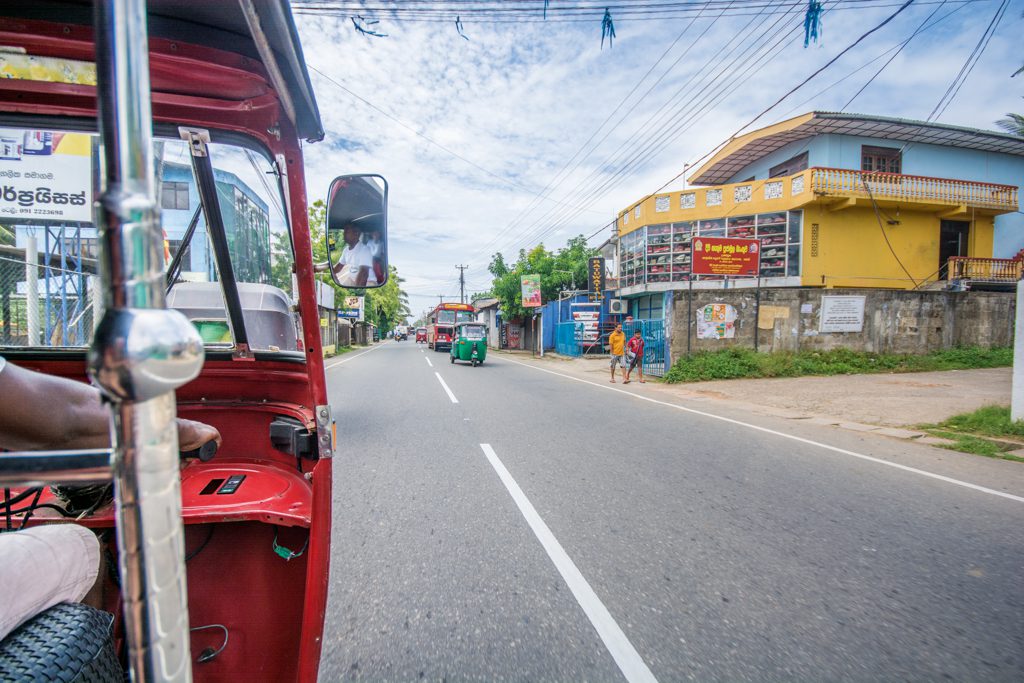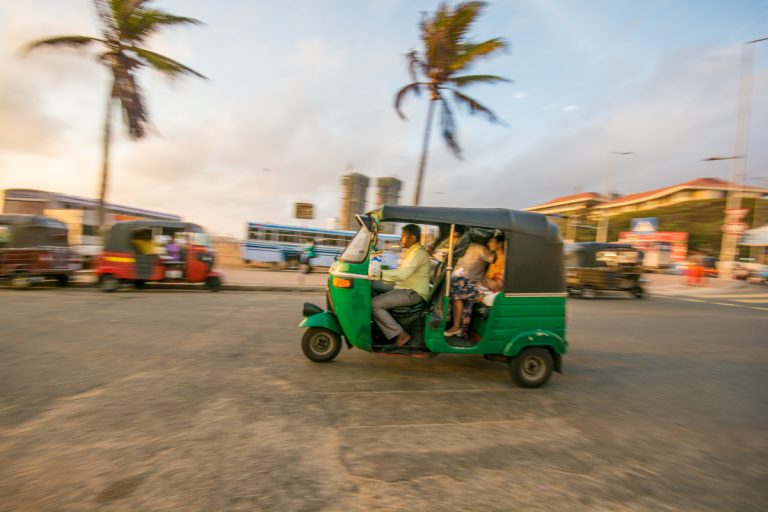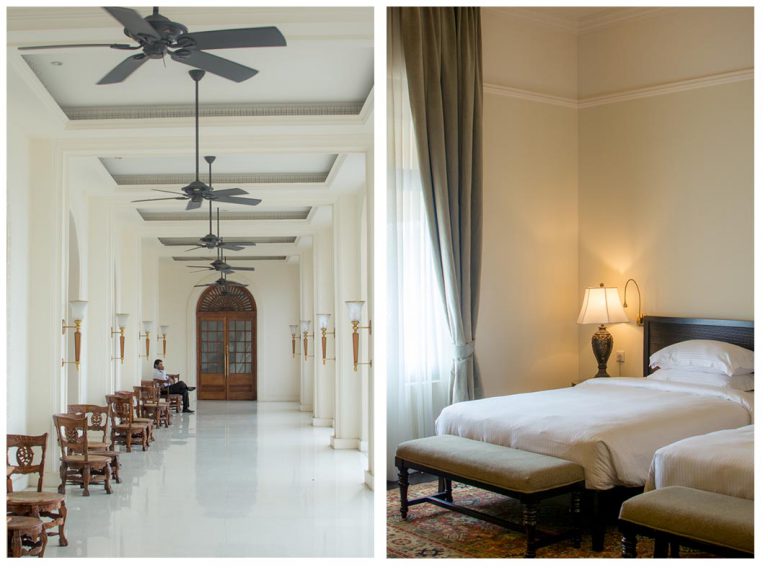Sri Lanka is the next big destination – it’s easier than India, cheaper and less busy. And it’s in Sri Lanka that Airbnb becomes very useful in helping uncover treasures.
Also read: Sussing out Sri Lanka – exploring the other side of the Indian Ocean

A bus drives along the coast of Southern Sri Lanka.
A thump of thick, hot air settles over me at the arrivals area. I’m alone in a foreign country that feels daunting despite being just a small droplet-shaped island in the Indian Ocean. Hugging my camera closer, double check my passport is still in my pocket and scan a sea of faces for the one I‘d seen on the website. I soon spot Chamara de Silva, my first Airbnb host in Sri Lanka and breathe out, letting my shoulders sag a little, relieved to see a familiar face.
We join the old coastal road that heads south from the airport and the country’s capital Colombo and it reminds me of the terrifying driving in Mozambique – buses come tearing up the wrong side of the road (they drive on the left like we do in South Africa) and tuk-tuks toot their way in between the big machines with enchanting bravado. Lorries, dogs and bicycles fearlessly enter the fray. Chamara hums along to Sinhalese songs on the radio. ‘They like to sing romantic songs,’ he says. He then presses some buttons and Shakira’s voice fills the air. It’s ‘Waka Waka’ from the 2010 Soccer World Cup.

Fishing boats in the harbour close to Hikkaduwa.
Hikkaduwa is my first stop and it’s busy, very developed and the beach is not the idyllic Instagram- worthy image I’d hoped for. I’d imagined palm trees and more of a wild unspoilt destination but there’s a strip of hotels and restaurants blocking the sea. Despite my initial dismay, I’m really chuffed to be here for my first night in Sri Lanka and I’m so impressed by Chamara who’s a gracious host and my unofficial guide. I’m staying in a beautiful apartment called The Residence Hikkaduwa next to his home; there’s ‘Welcome’ arranged in petals on my bed and I’m gifted with a plate of Sri Lankan treats – some kind of delectable ginger sweet I’ve never tasted before, but I’m soon licking its delicious sticky residue off my fingers.

The Residence in HIkkaduwa is set in a lovely, private garden beside the owner’s home. For breakfast I had the traditional yellow dhal, caramalised onions and a coconut roti with Sri Lankan tea.
Chamara recommends things to do – one of them is the Tsunami Museum and it’s a sobering visit. Sri Lanka was hit hard and the scale of damage is only visible when you walk the same ground you’ve seen in the photographs. It’s overwhelming. The lady sitting at the museum door smiles and asks where I’m from – this is a common greeting and people are genuinely interested in the answer – I say ‘South Africa’ and she asks if I know Shakira.
The next morning, I awake refreshed and feeling pluckier than I did in the arrivals hall; I’m easing into life in a new place and my mood is matched by a sensational Sri Lankan breakfast of fresh crisp fruit, mildly spiced yellow dhal curry and sticky coconut sambals with a squeeze of lime, all washed down with a cup of locally picked tea that I finish far too quickly.

From inside the tuk-tuk heading to Dikwella
Chamara has organised a tuk-tuk at a decent price to take me to my next stop, a dreamy-looking tree house in Dikwella that I’d booked on Airbnb. Initially he and the driver are unsure where Dikwella is, and that same sinking feeling wells up in me again with a sense of foreboding ‘I’ve made a horrible mistake and I’m travelling alone in a foreign country’. But the fact that even locals don’t know Dikwella’s precise location turns out to be the blessing I’ve been waiting for.
I finally find my postcard paradise – a secret bay called Hiriketiya beach with a cluster of small fishing boats tucked around the feet of tall palm trees and only one open restaurant on the beach – leaving the rest as nature intended. Surfers scuttle along the ‘rough’ sea (people here have obviously never seen our side of the Indian Ocean) and the tree house is everything Airbnb promised. There’s a freshly cut king coconut waiting for my arrival and I sip its cold, crisp juice – an instant pick-me-up after my two-hour journey.

The postcard-perfect paradise beach in Dikwella, where a fresh coconut was waiting.
I’m struck by how similar Sri Lanka is to South Africa – a hornbill sits in the tree, a squirrel dashes by in the garden below and I even come across an enormous monitor lizard sliding up the embankment near the sea. Later I hear a striking kingfisher call that’s both familiar and different all at the same time and catch its ash of colour before it settles on an electricity pole. Its bill is unmistakable, but I’m unable to find one with its colouring in the Newman’s bird book. Here the Gondwanaland theory – that all the continents broke away from one large supercontinent – really comes to life and I try to visualise where on the map Sri Lanka would’ve once sat on the shore of Africa.

We see the empty stilts used by fisherman along the coastal road.
There are two tree houses and my neighbours, Nick and Anna, a lovely Belgian couple, share invaluable advice: tuk-tuks should charge roughly R10/km; travel by bus isn’t as terrifying as it looks (and they play nice music, ‘better than in Vietnam’); and waking up early to visit the tea factories will ensure you see the production in action.

Bokkoms and the Indian Ocean, both close to Dikwella.
We travel together to see local sights such as the harbour and vendors selling dried fish, which look so much like bokkoms. As we walk, a stallholder asks where I am from. ‘South Africa’ I say and he responds ‘Pretoria?’ Genuinely astonished, I ask how he knows about Pretoria. It turns out he can name the capital of most countries and all of our star cricket players, as far back as Hansie Cronje.

A lady carried coconut fibres along the beach in Dikwella.
Samitha Darshana Wanigabadu is my tree-house host. He opened his accommodation very recently, and is hoping that the area doesn’t develop too much, ‘otherwise people won’t come here’. I think back to Hikkaduwa and have the same hope. Samitha has arranged dinner for me – a simple, but really impressive buffet of calamari, potato curry, sambals and coconut rotis. For breakfast there is buffalo curd with treacle because I mentioned wanting to try it after spotting some being sold on the roadside during the journey here. The curd is like yoghurt, creamy with a wilder taste, almost like goat’s cheese.

Buffalo curd for breakfast served with thick coconut syrup.
I would like to spend the rest of my holiday soaking up the blissful island life in Dikwella, but there is still so much of Sri Lanka to see and Galle Fort, a Unesco Heritage Site (the island has eight – another parallel to home) is next on my list – a well- preserved edifice built by the Portuguese in 1588.

Locals play cricket on the streets of Galle Fort.
The best way to explore a new place is to walk it and the fort’s ancient streets succumb to my desires for genuine encounters. There is a courting couple sharing an umbrella to shield the sun, families sitting on the fort walls enjoying their Sunday and around every corner, there’s a casual cricket game being played.
I see a man in a sarong (most men here wear a collared shirt, a sarong and sandals) selling freshly squeezed lime juice from a table that looks like a school desk. A traditional press is clamped to it and he mixes the extract with bottled water. The tart juice is heavenly in the heat and goes perfectly with my spiced green mango and vetkoek-like savoury pastry called ulundu that’s wrapped up in a recycled paper pulled from a notebook. It looks a lot like maths homework and I love that it echoes the school-desk theme.

Delectable lime juice sold by vendors in Galle Fort.
My bed for that night is at The Magical Apartment, cocooned in a network of picturesque alleys within the old thick walls that stood rm against the tsunami. The owners have an indoor terrarium and the leafy greenery makes it feel like an oasis. I dread to leave because it’s everything I’d hoped for and more – authentic Sri Lanka and wonderful hosts, Ranjit Goonewardena and his wife Moninna, who share tea and biscuits with me in their kitchen downstairs.

An old classic call on the cobbled streets of Galle Fort and my Airbnb host Ranjit Goonewardena.
I head back north to Colombo and, here too, I see families bonding in the city on an ordinary Tuesday evening; locals swim in the sea below the pier on the Galle Face Green (a five-hectare oceanfront park) and there are too many kites to count. It’s the windy season and perfect weather for this traditional sport. I see children running alongside their parents, flying their kites as high as they can, and afterwards eating hot diced roti with spiced fish (my favourite meal of the trip) on the promenade as the sun goes down.

The busy promenade at the Galle Face Green is filled with vendors and locals.
The tuk-tuk driver who takes me to my final stop, the iconic Galle Face Hotel on the seafront – a real beauty with a rich historical past – also asks about Shakira as he ducks and dives between oncoming headlights. Of the locals I met in Sri Lanka, many had never encountered a South African. Yet we had so much in common – cricket, wildlife, the size of waves in the Indian Ocean, and Shakira. I know for a fact that they would like to meet more.
Plan your trip to Sri Lanka
Getting there
I flew with Emirates to Colombo for R7 200 (including a Discovery Vitality discount). emirates.com
Need to know
South African passport holders need a visa. It costs R490 ($35) and can be applied for online. eta.gov.lk/slvisa
Take dollars to exchange with the Sri Lankan rupee. Accommodation and water-based activities are your biggest cost. Food, drinks and transport cost little. It’s best to visit in the drier months from November to March (although, it can still rain). I went in September – it didn’t rain, but the sea was fairly choppy. Use tuk- tuks for short distances – they are affordable and easy. Buses are less comfortable, but cheaper. Private taxis (sedans) can be organised with most accommodation owners, but they are much pricier. Uber operates in Colombo.
Do this

A typical Sri Lanka tuk-tuk.
Visit the Tsunami Museum in Hikkaduwa. It’s at AH43, Telwatta (ask your host for directions). Free entry.
Take a tuk-tuk along the coastal road from Galle Fort to Dikwella (about R385). If your driver is kind like mine was, he’ll pull over so you can take pictures and grab a bite to eat. Your host can arrange a tuk-tuk to pick you up
Walk the fort walls in Galle Fort and explore the cobbled alleys with its boutique shops and vendors along the way.
Learn to surf at Hiriketiya beach in Dikwella. There’s good waves year round and it’s a quiet sheltered spot. From R350 pp. salthousesrilanka.net
Stay here

Classic colonial-style interiors at the plush Galle Face Hotel.
The Residence at Hikkaduwa has two enormous rooms with wonderful, clean facilities. From R989 per room (sleeps two). airbnb.com/ rooms/8456170
The Magical Apartment in Galle Fort is spacious, airy and within the old section of the fort. From R820 (sleeps two). airbnb.com/ rooms/1006151
Sea View Treehouse in Dikwella was one of my favourite stays in Sri Lanka and close to two gorgeous beaches. Samitha, the host, said it’s best to visit in November. His father is a diver and fisherman and can arrange an ocean activity. From R594 B&B (sleeps two) and R80 pp for dinner. airbnb.com/ rooms/8869417
Galle Face Hotel in Colombo looks over the sea and has lots of places to eat nearby. The hotel is a little pricier than others, but is a real treat and I was happy to end my trip here. From R1 900 per room (sleeps two). gallefacehotel.com
Eat here

Dinner at Nana’s and the view from the promenade of the Galle Face Green.
Mamas Galle Fort Roof Café has a view of the fort and excellent curries. Beer is not on menu, but ask for it. From R80 pp for a curry. mamas-galle-fort.com
Nana’s on the Galle Face Green is ideal for watching the local life, and it serves authentic, affordable food. From R80 for two. Galle Face Drive, Colombo.
Ask your host to arrange meals for you. I found some to be the most affordable and best meals on my trip.
Read more from this story in the January 2017 issue of Getaway magazine.
Get this issue →
Our January issue features a bucket list of 45 experiences to have at least once in South Africa, a new way to experience the Wild Coast, and a beautiful beach holiday in Sri Lanka.
You may also like
Related Posts
With the nickname 'Jewel of the Pacific' you'd expect Valparaíso to be a sparkling kind...
read more
Most visitors to Vietnam will arrive in Saigon first. Instead of rushing off elsewhere, linger...
read more
Andrew Thompson explains how South Africans can enjoy the beauty of Switzerland without completely blowing...
read more